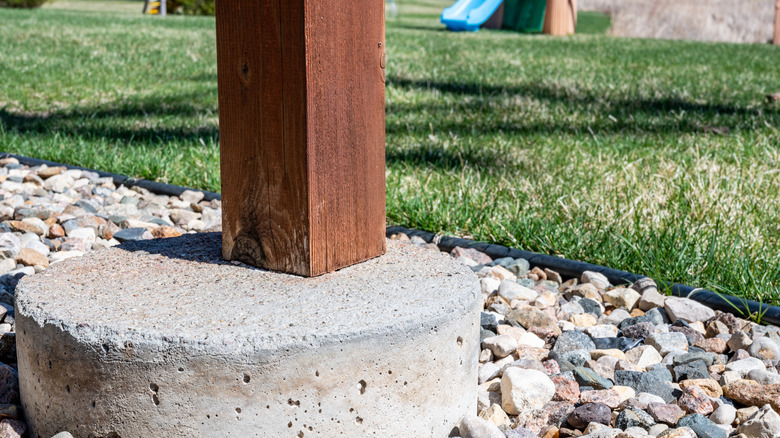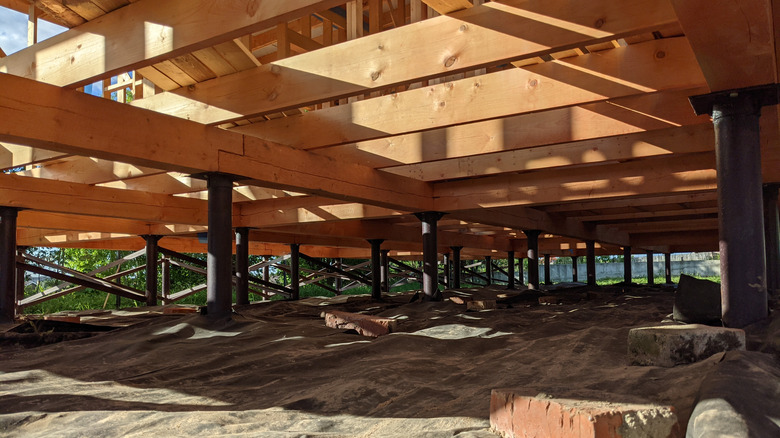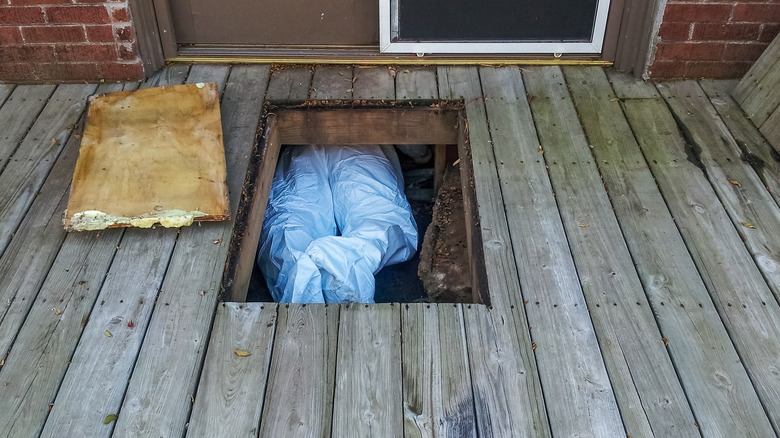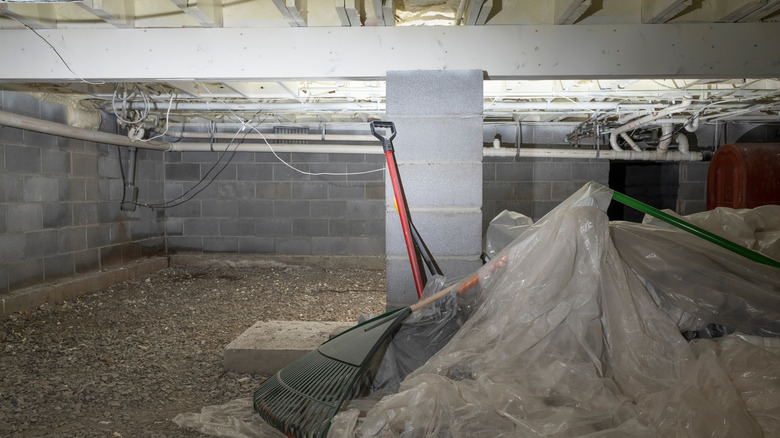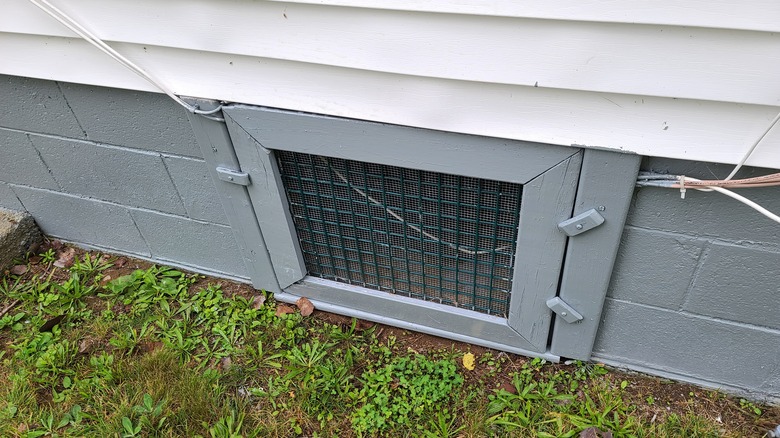How Much Does It Cost To Install A Pier And Beam Foundation
A pier and beam foundation is a common sight in older homes. Rather than the uniform concrete slab that makes up the aptly named slab foundation, a pier and beam structural support utilizes deep holes spaced out across the area. This type of foundation begins in the bedrock where timber is sunk into concrete piers to provide support for the house or other structure that will be built on top (via Atlas Foundation Inc.).
Once the bottom section of the foundation has been established, a network of beams is added to create the horizontal layer of support that the structure will rest upon. A pier and beam foundation offers a cheaper overall cost than a slab foundation but can be problematic due to the crawl space area that invites rodents, cold air, and moisture retention if it's not well maintained (via Home Inspection Geeks). However, it should be noted that the crawl space created in this type of foundation—a defining feature of the pier and beam construction—provides easy access to wiring, plumbing, and other home system conduits that can make repairs and renovations easier and more affordable over the long term.
Basement Guides reports that a pier and beam foundation costs about $9 per square foot, with an average price for a typical whole-home installation ranging from an estimated $7,200 to $13,500.
Factors for cost
The most obvious factor that will influence the cost of a pier and beam foundation installation is the size. The larger your foundation needs to be, the more expensive the project will become. But this isn't the only cost factor that needs to be taken into consideration.
Foundation size is the predominant factor in the total cost
The size of the foundation is without a doubt the most cost-determining component of laying a foundation. Angi reports that the concrete used to create the foundation will cost between $3,250 and $13,500 with a cost per pier estimated at about $1,000 each. Simply put, the larger your foundation, the more expensive the project will become as a result of the increased workload, material requirements, and other considerations.
Another element that plays a role here alongside the overall size is any premiums that a builder might charge for this type of foundation—dependent still on the overall square footage of the base. Basement Guides reports that new homes built with a pier and beam foundation are few and far between, making this a special request of your builder rather than a typical design feature in many areas of the United States.
Labor expenses can make up half of the total bill
Angi estimates that labor costs can account for as much as 60% of a concrete foundation pour. This will likely be somewhat different for a pier and beam foundation, but you should still anticipate a large portion of the expense to come directly as a result of labor costs. The crew that will lay the foundation is made up of specialized concrete workers, and leveling, curing, and other steps involved in solidifying a foundation of any shape or size is a highly technical endeavor. Leaning on professionals in the industry is a must, and this comes with an unavoidable expense.
Planning and permitting are crucial to a successful foundation installation
Lastly, the installation of a foundation is a substantial undertaking, and the logistical preparation that goes into the project will play a role in the final price. Alongside these other cost factors, Angi also reports that the planning and permitting components that go into laying a foundation can cost between $2,000 and $10,000 to hire an architect and between $500 and $2,000 for local or city permits.
These factors might seem like unnecessary additions tacked on to the total price, yet they are instrumental to making sure that your foundation is built with safety and longevity at the forefront. A foundation that's installed without these safety checks and features included in the build is one that is sure to be the source of many problems in the future.
Additional costs
Maintenance and other elements will also play a role in the installation and ongoing financial aspects of a pier and beam foundation.
Prep work can add to the expense
Unlike a monolithic slab pour, a pier and beam foundation may require large-scale grading and excavating tasks before it can be installed. Leveling off the soil and excavating any problematic material in the target area can significantly add to the expense if extensive additional work is required, costing between $100 and $245 per hour with an added equipment rental fee ranging from $150 to $250 per day (via Angi).
A poured slab requires a flattened workspace as well (via Homebuilding & Renovating), but the natural process of pouring and then releveling the concrete layer makes the task of excavating potentially problematic material a far less important step. The thickness and cohesion of the pour give the foundation its structure whereas a pier and beam foundation must feature distinct concrete feet that each rest within a properly prepared location.
Drainage and waterproofing may be required to complete the foundation
Basement Guides recommends taking steps to defeat future moisture buildup in the underlayer of your home's structure. As you go about the construction of a pier and beam foundation, it's important to include waterproofing elements and drainage additions that can help deter excessive moisture buildup, which, in turn, can lead to mold growth, timber rot, and more.
Angi estimates that waterproofing the concrete elements of your pier and beam foundation is generally priced between $2,000 and $6,000, while draining additions typically average around $3,000. These added elements might seem like a significant addition to the overall cost of the foundation construction, but they will prevent future erosion and damage that can make for incredibly expensive foundation repair costs: Home Inspection Geeks reports an average repair bill ranging from $5,600 to $8,500 for a pier and beam foundation that's been damaged due to routine environmental factors like this.
Why you need a pier and beam foundation
Installing a pier and beam foundation underneath your home can provide easy access to utilities that make for a fantastic blueprint for continuous home improvement. Additionally, this type of foundation can be immensely beneficial for a homeowner looking to include a new raised section of decking alongside their existing home structure.
A pier and beam foundation is a cheaper alternative that frees up cash for other elements of a new home build
A pier and beam foundation is typically much cheaper than other types of foundation installations. This gives you the ability to reduce costs upfront and spend the excess portion of your budget on something else that will exist inside the home. Constructing a new property from scratch requires considerable planning, and compromises will need to be made at many junctures along the way (via Design Everest).
These foundations provide the perfect structure for exterior additions
Pier and beam designs are also great as an addition to the side of an existing property. Many raised decks employ the pier and beam foundation structure in order to support both the foundational needs of the new flooring element and the raised nature of this wooden platform (via Decks.com). This layout gives you the ability to install the timber component of each pier to your customized height requirements. Likewise, a pier design allows for a much larger deck than a poured pad.
Lastly, this dispersed design for an exterior decking foundation gives you the ability to make use of the under space as a storage solution (just like the crawl space underneath a home that utilizes this design). According to This Old House, installing storage solutions alongside a raised deck and pier-based foundation is a simple addition that can make for a much more efficient overall design.
Certain properties are at a great advantage by using this foundation design
Basement Guides recommends the use of a pier and beam foundation on homes that are built on uneven land or located in an area that is prone to flooding or humidity-driven soil movement. These issues can adversely affect a solid, poured foundation, leading to an increased risk of damage to the foundation itself or to the home that rests above it.
A home that's built on a steep, graded slope will likely demand the use of a pier and beam foundation because a flat poured slab doesn't have the ability to be constructed with uneven heights in mind. A pier and beam construction allows you to vary the heights at the top of each pier, creating a flat surface upon which you can build a home. This can be used to support construction on even some of the steepest grades that are seen in residential locations.
Likewise, when it comes to flood damage or moisture-related issues, raising the home off the ground provides a major benefit in the form of additional security for the property itself and the belongings that rest within it.
Benefits of a pier and beam foundation installation
From easy access to increased storage (when deployed to support an exterior decking addition, for instance), pier and beam foundations offer numerous positive elements.
Protection from flooding
Flood risk planning is a major consideration for home builders and homeowners all over the United States. Data associated with flood conditions and historical flooding events play an integral role in any cost basis of homeowners insurance (even as FEMA reports that insurance providers typically won't cover damage caused by flooding). Flood conditions are a big issue for homeowners in some of the more noticeable coastal regions, but The New York Times reported in June 2020 that flood risks exist in pockets all across the United States and in far greater concentration than was previously understood.
Flooding can devastate a home and the lifestyle that a family leads. Cleaning up afterward can take weeks or months, and any expense associated with this repair work is often astronomical. HomeServe estimates that flood damage can easily cost more than $10,000 to repair, while Fixr reports that a flooded basement alone typically costs between $2,000 and $7,000 to restore (with an average spend of $4,000).
Renovation-friendly features
Home Inspection Geeks reports that a pier and beam foundation offers increased access to essential utility services entering into the home. As the property is elevated off the ground, these essential services will be placed beneath the foundation rather than buried or worked around the concrete slab that supports your home. This gives homeowners the ability to engage in faster and simpler renovations and structural changes to the property.
This is great for homeowners who are looking to continue the transformation of their living space over the coming years. Home improvement projects are a major component of U.S. homeownership, with spending in this category continuing to increase substantially each year since 2009, and projected to see similar expansion through 2025 (via Statista).
A pier and beam foundation can make all the difference for a homeowner seeking increased renovation options for the future. This allows for increased customization opportunities and a lower overall cost on many of the expansion options that exist for homeowners in the current market, even the option to pull up the home and relocate it to a new plot of land.
Added crawl space storage options
The crawl space that is built naturally into a pier and beam foundation allows homeowners to take advantage of a major increase in storage space. The Interior Revolution suggests adding shelving, airtight containers, or even a root cellar for storing vegetables grown in your garden. Taking advantage of the crawl space can provide your home with a massive boost when it comes to organization and storage, which is often in short supply when it comes to modern home floorplans.
